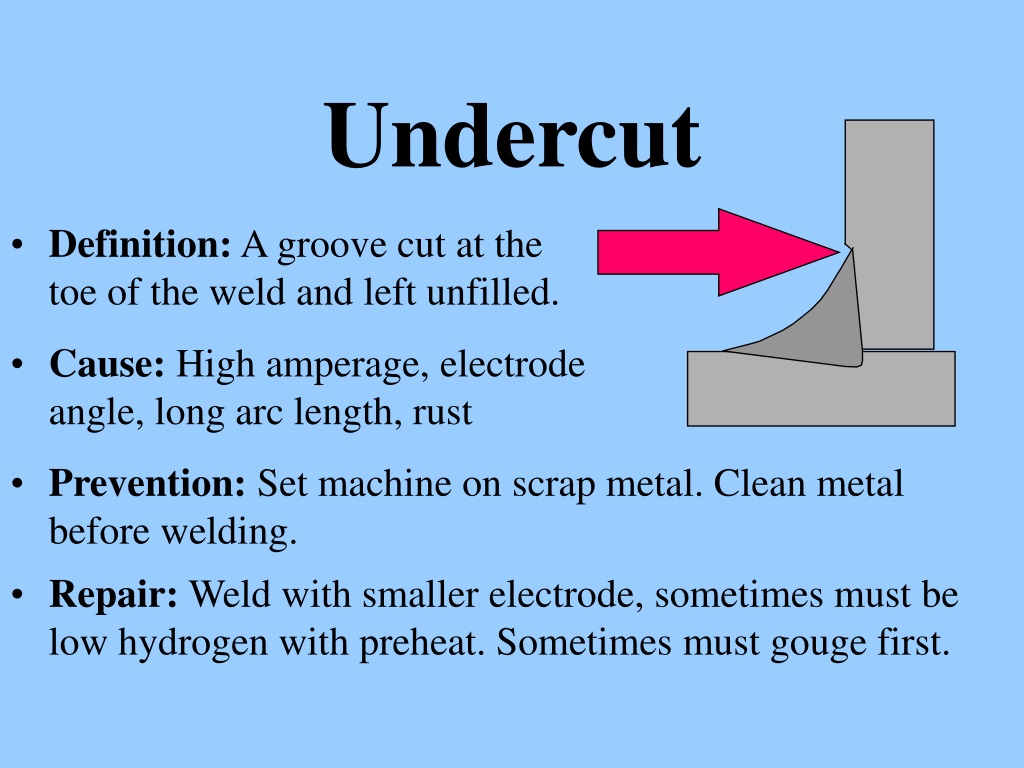Your Total Handbook to Preventing Weld Undercut Like a Pro
Your Total Handbook to Preventing Weld Undercut Like a Pro
Blog Article
Mastering the Art of Welding: Just How to Prevent Undercut Welding Issues for Flawless Manufacture Results
By recognizing the origin creates of undercut welding and implementing effective methods to avoid it, welders can raise their craft to new levels of excellence. In the quest of perfect construction results, grasping the art of welding to avoid undercut issues is not simply a skill however a need for those aiming for perfection in their job.
Understanding Undercut Welding

To prevent undercut welding, welders should make sure correct welding criteria, such as readjusting the existing, voltage, traveling rate, and keeping the proper electrode angle. By understanding the reasons of undercut welding and implementing preventative actions, welders can achieve top notch, structurally audio welds.
Reasons of Undercut in Welding
Comprehending the elements that contribute to undercut in welding is necessary for welders to create premium, structurally sound welds. Damaging happens when the weld metal does not properly load the groove created between the base metal and the previously deposited weld metal. Several elements can result in undercut in welding. One usual cause is excessive warmth input. Welding at high temperature levels for prolonged periods can cause the base steel melting greater than preferred, causing undercut. Poor welding present or incorrect welding speed can additionally add to undercut. Not enough current may not supply sufficient heat to melt the base and filler steels appropriately, while too much rate can avoid correct combination, creating undercut. Additionally, improper electrode angles or wrong torch adjustment techniques can develop areas of low weld metal deposition, promoting undercut. Comprehending these causes and carrying out proper welding techniques can aid prevent damaging concerns, making sure long lasting and strong welds.
Strategies to Avoid Undercutting

To mitigate the danger of damaging in welding, welders can use strategic welding techniques targeted at improving the quality and stability of the weld joints. One efficient technique is to change the welding criteria, such as voltage, existing, and take a trip speed, to guarantee appropriate warm input and deposition. Preserving an appropriate electrode angle and ensuring constant travel speed can also help avoid undercut. In addition, making use of the correct welding strategy for the details joint arrangement, such as go to the website weave or stringer grains, can add to decreasing undercutting. Preventing weld undercut.
Moreover, proper joint preparation, consisting of making sure tidy base materials devoid of contaminants and making use of the proper welding consumables, is important in avoiding undercut problems. Using back-step welding strategies and managing the weld grain account can additionally aid disperse warm evenly and decrease the danger of undercut. Routine assessment of the weld joint during and after welding, along with executing high quality guarantee measures, can help in addressing and identifying undercutting issues without delay. By carrying out these techniques carefully, welders can attain perfect fabrication results with very little undercut issues.
Relevance of Proper Welding Parameters
Choosing and keeping ideal welding parameters is necessary for attaining successful welds with very little issues. Welding parameters refer to variables such as voltage, current, travel more tips here speed, electrode angle, and securing gas flow rate that directly impact the welding process. These parameters need to be carefully adjusted based on the sort of material being welded, its thickness, and the welding method used.
Correct welding criteria make certain the appropriate quantity of heat is put on melt the base steels and filler product evenly. If the criteria are established expensive, it can lead to excessive heat input, causing burn-through, spatter, or distortion. On the other hand, if the specifications are too low, insufficient blend, absence of penetration, or undercutting may take place.
Top Quality Assurance in Welding Operations

Final Thought
To conclude, mastering the art of welding calls for a comprehensive understanding of undercut welding, its reasons, and techniques to avoid it. By guaranteeing correct welding parameters and implementing quality control techniques, remarkable manufacture outcomes can be attained. It is important for welders to continually pursue quality in their welding procedures to avoid undercut issues and create premium welds.
Undercut welding, an usual problem in welding processes, occurs when the weld steel doesn't effectively fill the groove and leaves a groove or anxiety along the welded joint.To prevent undercut welding, welders must make sure appropriate welding parameters, such as adjusting the existing, voltage, traveling speed, and maintaining the right electrode angle. Poor welding incorrect or present welding rate can likewise add to undercut.To mitigate the threat of undercutting important link in welding, welders can employ critical welding strategies aimed at boosting the top quality and honesty of the weld joints.In conclusion, grasping the art of welding needs a complete understanding of undercut welding, its reasons, and techniques to avoid it.
Report this page